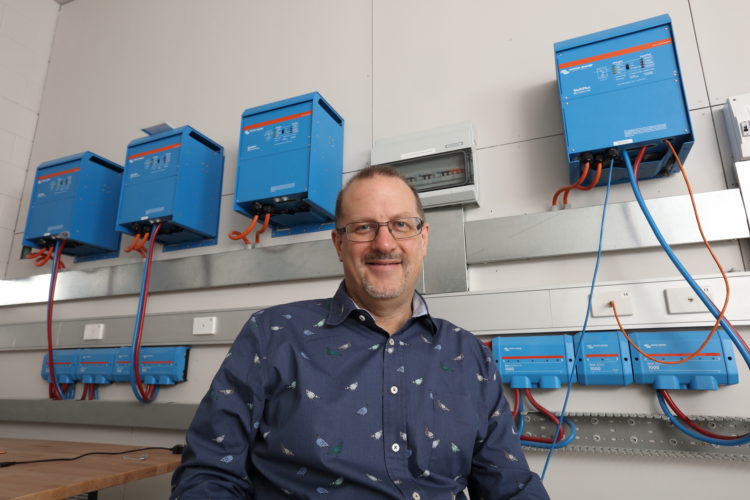
There is far more to Victron Energy’s Color Control GX than immediately meets the eye. Whilst browsing the ever expanding capabilities of the Color Control, I became curious about some of the more elusive options.
Digging a little further I discovered a company rated in a top 20 list of ‘Energy storage disruptors’, that uses the Color Control in innovative ways. That rated company is Redflow and they are avid integrators of Victron Energy products, which includes using the Color Control GX and other products such as the Quattro and Multiplus with their flow battery systems.
Product integration
Whilst Victron products work with many common battery technologies, energy storage disruption technologies (such as flow batteries) often require a deeper integration and communication between their power electronics and battery management hardware.
You can learn more about Victron/Redflow integration at Victron Live, but maybe the best way to discover more about a top energy storage disruptor is to start with a guest blog from Redflow themselves.
Guest blog
This guest blog content, in its edited form, was first published in Solar Nexus Today under the title, ’20 energy storage disruptors’.
Going with the flow: Looking beyond lithium batteries
By Redflow Limited Executive Chairman Simon Hackett
“After embracing photovoltaic solar panels to generate their own power, householders globally are now looking to take the next step by using batteries to store that energy for when it’s needed.
Although many companies, including Tesla, Enphase and Panasonic, have chosen lithium-based chemistries for their batteries, it’s important to recognise that not all batteries are created equal.
I’m the proud owner of multiple Tesla electric cars and believe that Tesla’s lithium-based pack is the ideal battery for automotive applications.
However, I believe there are more compelling chemistries, such as zinc-bromine flow batteries, for stationary battery applications such as residential, commercial and grid-scale energy storage.
To understand why, it’s necessary to recognise the distinction between “power” and “energy” batteries.
A “power” battery is a sprinter, able to serve short sharp bursts of power when required, whereas an “energy” battery is more of a marathon runner, delivering energy consistently, day in and day out.
An example of a “power” battery is found in Tesla’s Model S P85D electric car. a lithium-based battery that stores 85 kilowatt-hours (kWh) of energy. While that equates to drawing one kilowatt for 85 hours, the outcome is quite different when a driver mashes his foot to the floor – launching this big luxury sedan like a railgun as its twin motors draw more than 500 kW from the battery pack.
But maintaining the power-draw rate at that huge level would exhaust the battery in minutes and make it very hot, perhaps dangerously so. Thus, a “power” battery fits a light duty cycle, with occasional bursts of activity, plenty of rest time rather than active charging/discharging, and a small average depth of discharge, suited for typical daily driving cycles.
In order to provide the long-term, relatively constant power supply that emulates a baseload power generator and to combine seamlessly with renewable energy sources, you need an “energy” battery.
An example of this is the flow battery, such as the zinc-bromine flow battery made by Redflow, which offers a distinctly different approach to energy storage.
Redflow’s flow battery contains about 100 litres of a water-based zinc bromide salt solution circulating through two separate hydraulic circuits. When charging, zinc is extracted from the zinc solution and stored on a plastic membrane. During discharge, zinc is released back to the solution.
With flow batteries, this process is completely reversible, with no damage to the battery through each discharge cycle. This process delivers some unique benefits to flow batteries including:
- 100 per cent depth of discharge without battery degradation or damage. The harder you work a flow battery, the better!
- Prolonged standby: Flow batteries can be fully charged, then shut down and left in standby mode for months or even years. Virtually all this stored energy is available within 30 seconds of restarting
- No reserve power requirements: Flow batteries can be completely discharged to zero volts without suffering damage and can stay fully or partially discharged for prolonged periods
- Robust performance: Flow batteries are extremely tough, able to handle ambient temperatures as high as 50°C / 122°F without active cooling
- No risk of thermal runaway or fire if physically damaged or shorted out as the battery’s electrolyte is inherently fire-retardant.
Redflow has designed the world’s smallest flow batteries – one fifth the size of previous flow batteries – which are installed in the US, Europe, Asia, Africa and Australia. Redflow energy storage systems range from its ZCell home battery and ZBM commercial batteries to its grid-scale LSB (Large Scale Battery) solutions.
Flow batteries are proven to deliver unique advantages over lithium-based batteries, which makes them well worth evaluating if you are choosing an energy storage system for your home or business”.
Conclusion
It’s always a pleasure to host a guest blog and read about fascinating technologies. Our thanks to Simon and Redflow for the content used in this blog. If you want to learn more please see the following links:
https://www.facebook.com/redflowenergystorage
https://www.facebook.com/ZcellAU
John Rushworth












 #victronenergy #adventure
#victronenergy #adventure
 ELECTRICS
ELECTRICS 
